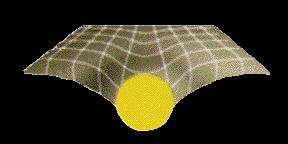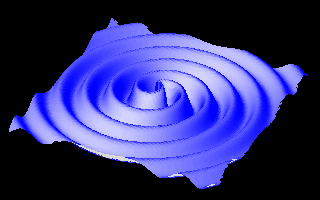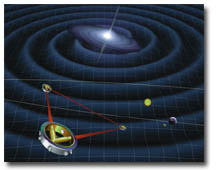On the Edge:
Gravitational Waves
At the NASA Goddard Space Flight Center's Laboratory for High Enery
Astrophysics, a new research group is devoting their collective effort to
understanding and detecting gravitational waves. Scientists are creating
computer programs to model gravitational waves that will be detected by a NASA/ESA mission called LISA (Laser Interferometer Space Antenna).
General Relativity
In 1916, Albert Einstein published his famous Theory of General Relativity. His theory describes how spacetime is affected by mass. We can think of spacetime as a fabric that bends or curves when we place an object on it. Keep in mind that the 2-dimensional fabric analogy is just a model we use to represent what is actually 4-dimensional spacetime (the normal three dimensions of space, plus a fourth dimension of time).
 |
|
Illustration showing the affect the mass of the Sun has on spacetime. |
|
Imagine pulling a sheet taut and placing a bowling ball in the center of it; you will notice that the ball produces a curve in the sheet. The curve is weak far away from the ball, and steeper near the ball. In fact, the sheet is a bit stretched in that area near the ball, as well. This situation describes the curvature of spacetime, and how it is affected by mass. Near a mass, spacetime curves more drastically and stretches. Near a very large mass, the 'dent' in spacetime is very deep, and the stretches are near the breaking point. This means that since spacetime stretches near a mass, not only is space stretched out, but so is time. What do you think would happen if you put something extremely heavy on the sheet? Obviously, you might have a hard time holding the sheet up, but imagine that you had some help from Superman. The heavy object would break through the sheet! In space, this is what we call a black hole. The mass is so large that anything that comes near it (even light) falls through the hole, and is never able to return.
So What is a Gravitational Wave?
 |
The binary system at the center of this animation creates graviational waves that propagate outward, away from the source.
(Credit: Animation by Willliam Folkner, LISA Project, Jet Propulsion Laboratory) |
|
Most scientists describe gravitational waves as "ripples in spacetime." Just like a boat sailing through the ocean produces waves in the water, moving masses like stars or black holes produce gravitational waves in the fabric of spacetime. A more massive moving object will produce more powerful waves, and objects that move very quickly will produce more waves over a certain time period.
Where Do Gravitational Waves Come From?
Gravitational waves are usually produced in an interaction between two or more compact masses. Such interactions include the binary orbit of two black holes, a merge of two galaxies, or two neutron stars orbiting each other. As the black holes, stars, or galaxies orbit each other, they send out waves of "gravitational radiation" that reach the Earth, However, once the waves do get to the Earth, they are extremely weak. This is because gravitational waves, like water waves, decrease in strength as they move away from the source. This strength decrease occurs because the energy that propagates from the source is spread out over larger and larger areas, causing the signal to 'thin out.' Even though they are weak, gravitational waves can travel unobstructed within the 'fabric' of spacetime, unlike light, which is obstructed by matter. This how gravitational radiation is able to reach the Earth and provide us with information that light cannot give.
How Can We Detect Gravitational Waves?
 |
|
LISA (Laser Interferometer Space Antenna), NASA's space-based observatory, will use interferometry to detect gravitational waves. |
|
Since the waves are so weak when they reach us, scientists had to use their imaginations to come up with instruments sensitive enough to detect such slight variations in spacetime. Interferometry is the technique scientists and engineers use to detect small stretches in spacetime. The technique requires test masses to be set at a large distance from each other. Lasers make continuous measurements to monitor the change in distance between the masses. The masses are free to move so that when a gravitational wave passes, the distance between the masses will fluctuate. That is, spacetime will be stretched. The lasers record this variation in distance, and the scientists know that a wave has passed. There are currently several ground-based interferometer detectors in operation or under construction, including LIGO (USA), VIRGO (Italy/France), GEO (Germany/Great Britain), ACIGA (Australia), and TAMA (Japan). The space-based observatory LISA is scheduled to launch in 2011.
In order to detect gravitational waves, it is necessary to create a model of what the incoming waveform might look like. Since there are so many sources at a given time, scientists must create computer models of gravitational waves so they know what to look for in what seems like a huge mess of data. Dr. Joan Centrella, a theoretical astrophysicist at NASA's Goddard Space Flight Center, leads a team of scientists who create these models. Currently, the group is working on computer models of massive black hole coalescences that occur when the black holes at the centers of two colliding galaxies spiral into each other. "Once we have the models for this system, we can just substitute different masses for the black holes. That way, several models can be made from one program," says Dr. Centrella.
What Will We Learn From the Detectors?
Gravitational waves will help physicists and astronomers to understand some of the most fundamental laws of physics. They will also tell us about the dynamics of large-scale events in the Universe like the death of stars, and the birth of black holes. With LISA, scientists hope to probe through space and time, to observe the Universe just a fraction of a second after the Big Bang. Using this information, we may be able to learn more about how the Universe began and evolved as well as what might be in store for the future.
 See what else LISA will tell us! See what else LISA will tell us!
Additional Links
 Read more about LIGO. (http://www.ligo.caltech.edu/) Read more about LIGO. (http://www.ligo.caltech.edu/)
 Read more about VIRGO. (http://www.virgo.infn.it) Read more about VIRGO. (http://www.virgo.infn.it)
 Read more about GEO. (http://www.geo600.uni-hannover.de) Read more about GEO. (http://www.geo600.uni-hannover.de)
|
